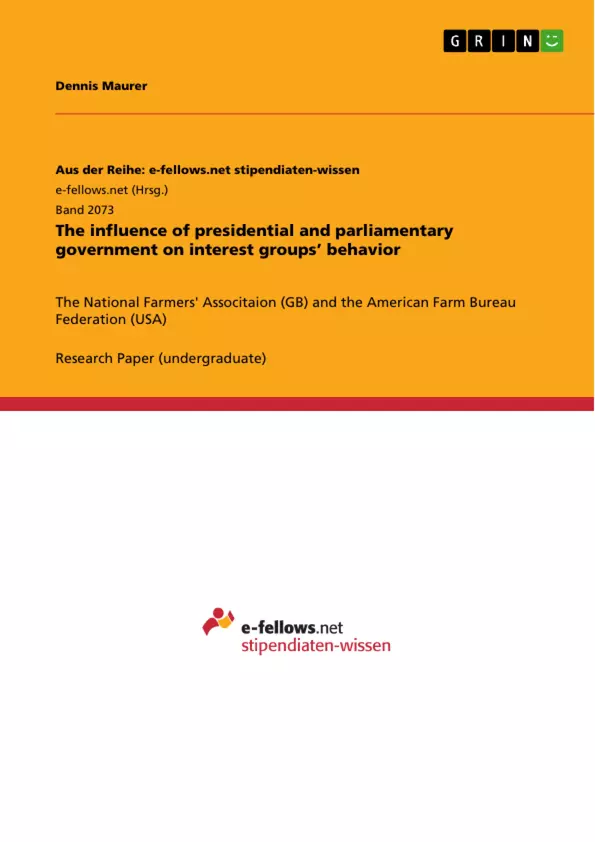Thanks to information, aggregation and interdependent politics, interest groups understand that in order to make themselves useful in manifold arrangements, with respect to politicians, parties and governments, they must provide information, expertise, donations, and develop political compromises with their members, to guarantee votes.
Two excellent examples are the National Farmers’ Union (NFU) in Great Britain and the American Farm Bureau Federation (FB) in the United States. Both of these organizations participate in the political environment, with a focus on rural business and living conditions. Both associations represent their clients and influence politics in different contexts, which leads to the purpose of this essay.
The overall aim is to build up a fundamental understanding of how different government systems are conceptualized, how interest groups operate at their access points abstractly from the inside, and to diagnose what actions the two interest groups already have in place which helps lead to their success. One should not just compare political institutions, but also assess the various roles and strategies of associations within presidential and parliamentary systems. In this course, different types of action, namely grassroots lobbying, buttonholing and general information exchange, are presented.
Accordingly, this paper begins by explaining the differences in necessary terms, followed by a differentiation method to distinguish parliamentary from presidential systems in a theoretical context. Then, Great Britain and the United States of America are analyzed with consideration to their specific interest groups in regards to their different stages of political participation. This represents the focus of this study paper. After that, two interest representation associations, namely NFU and FB are described with a special focus on their organization, competition, strategy and program. It is finished by a résumé.
As there is ongoing scientific research in regards to this topic, governments tend to develop anomalies over time in regards to their original governmental structure; this paper cannot guarantee topicality and completeness, however it will accurately analyze and connect specific practices with theory based on the predetermined limited scale of the essay.
Table of Contents
- Introduction
- Definitional delineation of terms within a pluralistic network
- Structure of presidential and parliamentary government systems
- Similarities of the pluralistic understanding of democracy
- Historical and systematical differentiation
- Country analysis with consideration of different stages of political participation on decision maker
- Great Britain
- Prime Minister and cabinet
- Parliament
- Civil Service
- Regional characteristics
- Electoral system
- Summary
- United States of America
- President and cabinet
- Parliament and presidential influence sphere
- Courts
- Independent Agencies
- Electoral system
- Summary
- Interest groups in the agricultural sector
- National Farmers' Union
- Organization and competition
- Program and strategy
- American Farm Bureau Federation
- Organization and competition
- Program and strategy
- Résumé
Objectives and Key Themes
This term paper aims to provide an understanding of how different government systems function, specifically focusing on presidential and parliamentary systems. It analyzes the influence of these systems on the behavior of interest groups, particularly the National Farmers' Union (NFU) in Great Britain and the American Farm Bureau Federation (FB) in the United States. The paper explores the strategies and tactics these interest groups employ to exert influence within their respective political contexts.
- Comparing presidential and parliamentary systems
- Analyzing the strategies of interest groups within different government structures
- Examining the role of the NFU and FB in the political landscape of their respective countries
- Understanding the influence of interest groups on policy decisions
- Exploring the impact of different government systems on agricultural policy
Chapter Summaries
- Introduction: The introduction sets the stage by explaining the importance of interest groups in political systems and introduces the NFU and FB as examples of such groups in the agricultural sector. It outlines the paper's goals and structure.
- Definitional delineation of terms within a pluralistic network: This chapter defines key terms related to pluralistic political systems and the role of interest groups within them.
- Structure of presidential and parliamentary government systems: This section provides a theoretical framework for understanding the differences between presidential and parliamentary systems. It discusses the similarities in their pluralistic understandings of democracy and the historical and systematical differences between them.
- Country analysis with consideration of different stages of political participation on decision maker: This chapter delves into the specific political structures of Great Britain and the United States, analyzing the respective roles of the prime minister, parliament, civil service, and other institutions within each system. It also examines the electoral systems and how they influence political participation.
- Interest groups in the agricultural sector: This section focuses on the NFU and FB, examining their organizational structures, competitive landscapes, and strategies for influencing political decisions in the agricultural sector.
Keywords
This term paper revolves around the key concepts of presidential and parliamentary government systems, interest group behavior, and the agricultural sector. It focuses on the specific examples of the National Farmers' Union (NFU) in Great Britain and the American Farm Bureau Federation (FB) in the United States, examining their strategies and influence within their respective political landscapes.
- Quote paper
- Dennis Maurer (Author), 2016, The influence of presidential and parliamentary government on interest groups’ behavior, Munich, GRIN Verlag, https://www.grin.com/document/338069



